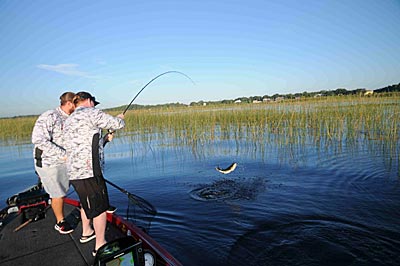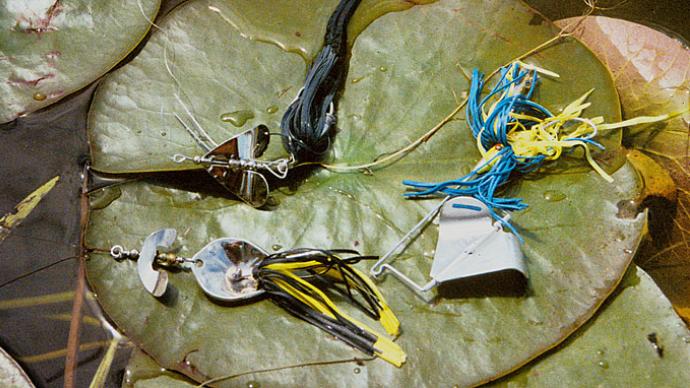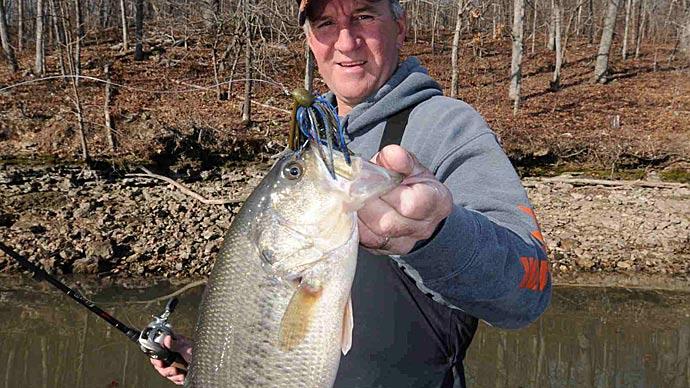
During the ICAST Cup at Florida’s Lake Toho, I got to fish a type of cover I rarely have a chance to target back home.
Lake Tohopekaliga (Toho for short) is loaded with various aquatic vegetation, a favorite bass cover that is scarce in the Missouri lakes I regularly fish. The ICAST Cup presented by FLW is a four-hour tournament held in July before the International Convention of Allied Sportfishing Trades (ICAST), pairing tournament pros with fishing manufacturers’ representatives and outdoor media members.
While paired with Florida tournament angler Erik Tilson and Kent Hickman of GILLZ LLC, I watched my partners catch most of our 16-pound, 14-ounce limit from Kissimmee grass, hydrilla, and reeds (buggy whips). I managed to catch one bass in the grass, but the biggest bass I caught was from an offshore brush pile.
Aquatic vegetation is ideal summertime cover for Florida bass because it provides plenty of shade, cooler water, and a migration route for the fish, according to Tilson. He noted Florida lakes don’t have contour lines bass can follow like they do on reservoirs, so the fish follow the weedlines instead. “They get out on that hard edge of vegetation which gives them a guide to travel up and down when looking for something to eat,” Tilson says.
When fishing long stretches of weedlines, Tilson targets the thickest vegetation he can find and any areas where there is a mixture of Kissimmee grass, hydrilla, and reeds. He believes the greatest concentration of bass can be found where those weeds intermesh. Other productive spots include aquatic vegetation that juts out into a point or indentations in the weedlines.
The positioning of bass in the weeds depends on the weather. “Most of it has to do with sunlight,” Tilson says. “That is the biggest contributing factor because the fish seem to be on the edge of the grass on a bright sunny day, traveling along looking for food first thing in the morning. Then, without a doubt, when that sun comes up, and it starts getting hot, they seem to move into the grass out of the sunlight.”

On cloudy days, Tilson notices bass seem to spread out everywhere in the grass. “You can catch them throwing a soft plastic swimbait or even a swimming frog by making long casts and reeling it across the vegetation,” he says.
Tilson believes big bass are “very efficient eaters” that save energy by looking for a big meal rather than trying to chase down small prey. So the tournament veteran targets bigger bass by flipping a 1-ounce Strike King Hack Attack Jig and a Strike King Rage Tail Craw. “I might not get as many bites as someone gets working a smaller bait, but I think I can get a few more big bites on a big lure,” Tilson says.
The USA Bassin’ and American Bass Association (ABA) tournament pro favors using a dark-colored jig to imitate bluegill, a favorite forage of big bass in thick vegetation. “I buy Okeechobee craw and black-and-blue glitter jigs because both have an essential common factor—blue glitter,” Tilson says. “I think blue glitter is a key component to big aggressive feeders.”
When flipping jigs, Tilson targets the outer edges of the weeds first. If that fails to produce, he flips his jig 1 to 2 feet inside the weeds. “I will continue that pattern until I figure out if the bass are staging on the outside edge or in the vegetation a couple of feet,” he says.
Tilson lets his jig drop to the bottom and then pops his rod tip several times to move the lure. If he doesn’t get a bite on the initial fall or see the weeds move “violently,” indicating a bass is after his jig, Tilson will quickly reel in his jig and pitch to another target.
The Florida angler will switch to flipping a black and blue glitter Bruiser Baits Stick Worm if the jig fails to produce in the weeds. Tilson Texas rigs the stick worm with a 1/2-ounce tungsten weight and employs the same presentation he uses for the jigs to tempt bass in the vegetation.
In the low light of early morning, Tilson catches some bass working a topwater bait (Strike King Popping Perch or Jackall Lures Kaera frog) in the weeds. Tilson varies his retrieve until he finds out how bass want the lure presented. “If there is a really good frog bite, typically it is going to be some form of a cadence they are after,” he says. “I usually give my frog two or three twitches and let it sit for a few seconds.”
Heavy line and tackle are a must for winching big bass from the weeds, so Tilson relies on the solid drag system of Abu-Garcia Revo reels and 65-pound Seaguar Smackdown Braided Line. He flips his jig with a Dobyns Champion 805 Flip/Punch rod and flips the stick worm with a Dobyns Champion 766 Flip rod.
BassResource may receive a portion of revenues if you make a purchase using a link above.




